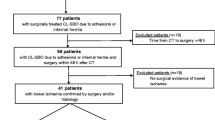Abstract
Purpose
To detect risk factors on clinical characteristics and multidetector computed tomographic (MDCT) findings for predicting bowel obstruction in patients with obturator hernia.
Methods
We retrospectively reviewed 47 patients who had an obturator hernia diagnosed by MDCT and/or surgery. The patients were divided into obstruction and non-obstruction group based on the presence or absence of bowel obstruction on MDCT images. Uni- and multivariate analyses were performed to identify risk factors for predicting bowel obstruction.
Results
There were 26 patients (55.32%) in the obstruction group and 21 patients (44.68%) in the non-obstruction group. Patients in the obstruction group were older (P = 0.002) and had more women (P = 0.033) and lower body mass index (BMI) (P = 0.0001) than patients in the non-obstruction group. The non-obstruction group suffered fewer bowel obstruction symptoms (P = 0.0001), Howship-Romberg (HR) sign (P = 0.012), deaths (P = 0.008) and major postoperative complications (P = 0.047). The hernia sac in the obstruction group had greater mean major diameter (P = 0.0001) and volume (P = 0.001) than those in the non-obstruction group. Multivariate analysis showed that age [odds ratio (OR) 1.18, 95% confidence interval (CI) 1.00–1.39, P = 0.046] and major diameter of hernia sac (OR 68.17, 95% CI 4.52–1027.70, P = 0.002) were independent risk factors associated with bowel obstruction in patients with obturator hernia.
Conclusions
Patient’s age and major diameter of hernia sac are independent risk factors resulting in bowel obstruction in patients with obturator hernia. Obturator hernia repair before bowel obstruction development may result in better outcomes and fewer postoperative complications.




Similar content being viewed by others
Abbreviations
- MDCT:
-
Multidetector computed tomography
- CT:
-
Computed tomography
- BMI:
-
Body mass index
- HR:
-
Howship–Romberg
- PPMVG:
-
Pneumatosis and/or portomesenteric venous gas
- OR:
-
Odds ratio
- CI:
-
Confidence interval
- PFDs:
-
Pelvic floor disorders
References
Ziegler DW, Rhoads Jr JE. Obturator hernia needs a laparotomy, not a diagnosis. Am J Surg 1995;170:67–68.
Lo CY, Lorentz TG, Lau PW. Obturator hernia presenting as small bowel obstruction. Am J Surg 1994;167:396–398.
Burt BM, Cevasco M, Smink DS. Clinical images. Classic presentation of a type II obturator hernia. Am J Surg 2010;199:e75–76.
Chang SS, Shan YS, Lin YJ, Tai YS, Lin PW. A review of obturator hernia and a proposed algorithm for its diagnosis and treatment. World J Surg 2005;29:450–454.
Yokoyama Y, Yamaguchi A, Isogai M, Hori A, Kaneoka Y. Thirty-six cases of obturator hernia: does computed tomography contribute to postoperative outcome? World J Surg 1999;23:214–217.
Cubillo E. Obturator hernia diagnosed by computed tomography. AJR Am J Roentgenol 1983;140:735–736.
Silva AC, Pimenta M, Guimarães LS. Small bowel obstruction: what to look for. Radiographics 2009;29:423–439.
Suri S, Gupta S, Sudhakar PJ, Venkataramu NK, Sood B, Wig JD. Comparative evaluation of plain films, ultrasound and CT in the diagnosis of intestinal obstruction. Acta Radiol 1999;40:422–428.
Mantoo SK, Mak K, Tan TJ. Obturator hernia: diagnosis and treatment in the modern era. Singapore Med J 2009;50:866–870.
Gray SW, Skandalakis JE, Soria RE, Rowe Jr JS. Strangulated obturator hernia. Surgery 1974;75:20–27.
Losanoff JE, Richman BW, Jones JW. Obturator hernia. J Am Coll Surg 2002;194:657–663.
Skandalakis PN, Zoras O, Skandalakis JE, Mirilas P. Richter hernia: surgical anatomy and technique of repair. Am Surg 2006;72:180–184.
Dindo D, Demartines N, Clavien PA. Classification of surgical complications: a new proposal with evaluation in a cohort of 6336 patients and results of a survey. Ann Surg 2004;240:205–213.
Light D, Razi K, Horgan L. Computed tomography in the investigation and management of obturator hernia. Scott Med J 2016;61:103–105.
De Clercq L, Coenegrachts K, Feryn T, et al. An elderly woman with obstructed obturator hernia: a less common variety of external abdominal hernia. JBR-BTR 2010;93:302–304.
Hodgins N, Cieplucha K, Conneally P, Ghareeb E. Obturator hernia: a case peport and review of the literature. Int J Surg Case Rep 2013;4:889–892.
Gianetta E, de Cian F, Cuneo S, et al. Hernia repair in elderly patients. Br J Surg 1997;84:983–985.
Steinke W, Zellweger R. Richter’s hernia and Sir Frederick Treves: an original clinical experience, review, and historical overview. Ann Surg 2000;232:710–718.
Kammori M, Mafune K, Hirashima T, et al. Forty-three cases of obturator hernia. Am J Surg 2004;187:549–552.
Petrie A, Tubbs RS, Matusz P, Shaffer K, Loukas M. Obturator hernia: anatomy, embryology, diagnosis, and treatment. Clin Anat 2011;24:562–569.
Grigoriadis T, Athanasiou S. Investigation of pelvic floor disorders. Climacteric 2019;22:223–228.
Arouca MAF, Duarte TB, Lott DAM, et al. Validation and cultural translation for Brazilian Portuguese version of the Pelvic Floor Impact Questionnaire (PFIQ-7) and Pelvic Floor Distress Inventory (PFDI-20). Int Urogynecol J 2019;27:1097–1106.
Good MM, Solomon ER. Pelvic floor disorders. Obstet Gynecol Clin North Am 2019;46:527–540.
Liu J, Tan SQ, Han HC. Knowledge of pelvic floor disorder in pregnancy. Int Urogynecol J 2019;30:991–1001.
Jelovsek JE, Chagin K, Gyhagen M, et al. Predicting risk of pelvic floor disorders 12 and 20 years after delivery. Am J Obstet Gynecol 2018;218:222.e1–19.
Altom LK, Snyder CW, Gray SH, Graham LA, Vick CC, Hawn MT. Outcomes of emergent incisional hernia repair. Am Surg 2011;77:971–976.
Acknowledgements
The authors thank pathology staff Hua-liang Xiao, computed tomography technician Qi-sheng Ran and Guang-kuo Guo for their help.
Funding
This study was supported by Grants from the National Natural Science Foundation of China (81671943).
Author information
Authors and Affiliations
Corresponding author
Ethics declarations
Conflict of interest
The authors declare that they have no conflict of interest.
Ethical approval
This study was approved by the ethics board of our institution and the requirement to obtain informed consent was waived because of the retrospective design.
Additional information
Publisher's Note
Springer Nature remains neutral with regard to jurisdictional claims in published maps and institutional affiliations.
Rights and permissions
About this article
Cite this article
Zhang, J., Zhang, Cl., Kuang, Lq. et al. Prediction of bowel obstruction caused by obturator hernia using risk factor categories on clinical characteristics and multidetector computed tomographic findings. Abdom Radiol 46, 4069–4078 (2021). https://doi.org/10.1007/s00261-020-02838-3
Received:
Revised:
Accepted:
Published:
Issue Date:
DOI: https://doi.org/10.1007/s00261-020-02838-3




